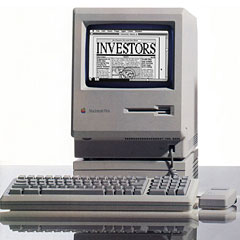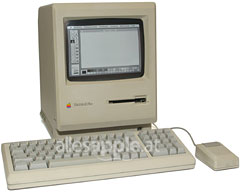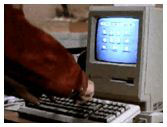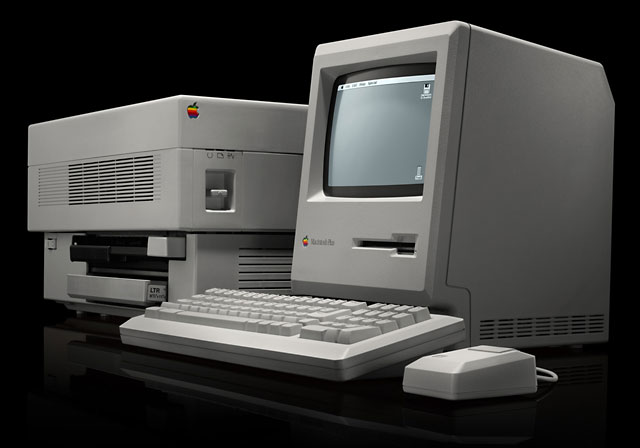Introduced in January 1986, two years after the original Macintosh, the Mac Plus shipped with 1 MB of RAM, a new double-sided 800 KB floppy drive, and a built-in SCSI port (the first Mac so equipped). Not only was 1 MB more RAM than PC-class machines could handle, but the Plus could be expanded to 4 MB total RAM! (Earlier Macs came with a fixed amount of memory with no upgrade path.)

The SCSI bus on the Mac Plus is officially rated at 1.25 MBps/10 Mbps by Apple, although real world testing shows it to be barely over 0.26 MBps/2.1 Mbps – which is still 4x the speed of Apple’s earlier floppy port hard drive.
The Plus does not support high density floppies, but it can be used with an external high density floppy drive as long as the disks used are 800K floppies.
 The original Plus came in Apple beige; during 1987 the case color was changed to platinum, the same color used for almost all post-1986 desktop Macs until the iMac arrived in 1998 (there were a couple black Macs). There are persistent rumors that the power supply in the beige Plus was less reliable and more prone to failure with 4 MB configurations, a problem addressed with an improved power supply in the “platinum” Plus.
The original Plus came in Apple beige; during 1987 the case color was changed to platinum, the same color used for almost all post-1986 desktop Macs until the iMac arrived in 1998 (there were a couple black Macs). There are persistent rumors that the power supply in the beige Plus was less reliable and more prone to failure with 4 MB configurations, a problem addressed with an improved power supply in the “platinum” Plus.
The Mac Plus was bundled with MacWrite and MacPaint, and Apple began to bundle HyperCard and MultiFinder in August 1987.
 Until the air cooled iMacs came out, all desktop Macs following the Plus and 512Ke up until the slot-loading iMacs have included a fan to reduce internal heat. Because the Mac Plus is convection cooled, you should never block the vents on the side or top of the computer.
Until the air cooled iMacs came out, all desktop Macs following the Plus and 512Ke up until the slot-loading iMacs have included a fan to reduce internal heat. Because the Mac Plus is convection cooled, you should never block the vents on the side or top of the computer.
Those used to newer Macs will find several keys missing from the keyboard: Esc and Ctrl, along with the Cmd and Option keys to the right of the space bar are simply not there. Neither is the power key, which existed on all Apple ADB keyboards and the first-generation USB keyboard.
The Plus and 512Ke were the last Macs not to use ADB ports for the keyboard and mouse – and the first to use mini DIN-8 serial ports. Discontinued in 1990, the Mac Plus had the longest product life of any Macintosh.

Mac Plus in Star Trek IV
The Mac Plus had a minor role in Star Trek IV: The Voyage Home.
On March 17, 1987, Apple pulled six units and declared them “the one millionth Macintosh”, giving these to Jef Raskin, Steve Wozniak, and others. (Apple Confidential 2.0, p. 98)
The Plus can become a reasonable Web server, as the Macintosh Plus Web Server demonstrated until it was retired in October 2001.
You can convert a non-working compact Mac into a Macquarium. (Please, don’t even think of converting a working one – you can always find someone interested on the Classic Macs or Vintage Macs lists.)
Tips
- If you have less than 4 MB installed, upgrade to 4 MB. You can often find pulled 1 MB SIMMs (removed from other Macs during upgrade) inexpensively.
- The Plus cannot use 2-chip 1 MB SIMMs.
- Memory permitting, set the disk cache to 128k.
- When a Plus is started-up, it loads the first system it finds in this order: floppy; SCSI ID 6, 5, 4, 3, 2, 1, 0. If you have a drive partitioned, and both partitions have a System Folder, it loads the partition that comes first alphabetically.
- To use HD floppies, look into the Applied Engineering AE HD+ external floppy drive. They are sometimes available on the used market. Note that the “plus” is important – the AE HD will not do the job.
You can download drivers for the HD+ drive from the Mac Driver Museum. - Rapport, a device called by Kennect Technology, allows you to access 720K DOS disks on a Plus. It attached to the drive port.
- Because of limited SCSI throughput, older hard drives with no buffer should normally be formatted with a 3:1 interleave for use with the Plus. (Unfortunately, other Macs may find it difficult or impossible to work with this interleave.) This is not an issue for newer drives with data buffers.
- If you use FWB Hard Disk Toolkit to format your hard drive, be sure to turn off command linking. “The Plus can go a little daft with it on.”
Details
- introduced 1986.01.16 at $2,600; discontinued 1990.10.15 – at 4 years and 10 months, Apple’s longest lived Macintosh
- code name: Mr. T
- Gestalt ID: 4
- Order no.: M0001A
Mac OS
- requires System 3.2 (System 3.0 and Finder 5.1) to 7.5.5
- addressing: 24-bit only
Core System
- CPU: 8 MHz 68000 CPU
- ROM: 128 KB
- RAM: 1 MB, expandable to 4 MB using pairs of 256 KB or 1 MB 150ns 30-pin SIMMs (memory upgrade requires clipping one or two resistors – details online at mia.net; cannot use two-chip 1 MB SIMMs)
Performance
- Performance: 0.87, Speedometer 3 ; 0.7 MIPS (see benchmarks)
Graphics
- 9″ b&w screen, 512 x 342 pixels
Drives
- floppy drive: 800 KB double-sided
- floppy connector on back of computer
- Hard drive: external SCSI
Expansion
- last Mac with keyboard attached via coiled telephone-like cable
- last Mac with mouse attached via DB-9 connector
- serial ports: 2 mini DIN-8 RS-422 ports for printer and modem
- SCSI ports: 1 DB-25 connector on back of computer, slow implementation limited to 2,104 kbps
Physical
- size (HxWxD): 13.6″ x 9.6″ x 10.9″
- Weight: 16.5 lb.
- PRAM battery: 4.5V PX 21 (a.k.a. Eveready 523, ANSI 1306AP, IEC 3LR50)
- power supply: 60W
Accelerators
- MicroMac Multispeed (16, 25, or 32 MHz 68030), optional 32 MHz 68882 FPU
- MicroMac Performer (16 MHz 68030), optional 25 MHz 68882 FPU
- MicroMac Performer Pro (32 MHz 68030), 64 KB cache, optional 32 MHz 68882 FPU
- Radius Accelerator 16 (16 MHz 68020 with 68881)
Some accelerators have onboard SIMM slots, allowing them to use more than 4 MB of RAM.
Discontinued accelerators (68030 unless otherwise noted) include the Brainstorm Accelerator Plus (16 MHz 68000), Dove Marathon Racer 030 Plus (16 MHz), MacProducts Railgun (33 MHz), and Novy ImagePro (16, 25, 33 MHz).
Color display? Aura Systems made ScuzzyGraph II, a SCSI peripheral that provided 8-color video for people who didn’t want to buy (or couldn’t afford) a Mac II. 1989 cost was $995 to $2,495, depending on resolution.
Online Resources
- Guide to Compact Macs, a quick overview of Apple’s 10 compact Macs.
- The Mac Plus 30 Years On, Dan Knight, 2016.01.16
- How I Introduced a 27-year-old Computer to the Web, Jeff Keacher, 2013.12.12.
- A Vintage Mac Network Can Be as Useful as a Modern One, Carl Nygren, My Turn, 2008.04.08. Old Macs can exchange data and share an Internet connection very nicely using Apple’s old LocalTalk networking.
- Vintage Mac Networking and File Exchange, Adam Rosen, Adam’s Apple, 2007.12.19. How to network vintage Macs with modern Macs and tips on exchanging files using floppies, Zip disks, and other media.
- Getting Inside Vintage Macs and Swapping Out Bad Parts, Adam Rosen, Adam’s Apple, 2007.12.14. When an old Mac dies, the best source of parts is usually another dead Mac with different failed parts.
- Solving Mac Startup Problems, Adam Rosen, Adam’s Apple, 2007.12.12. When your old Mac won’t boot, the most likely culprits are a dead PRAM battery or a failed (or failing) hard drive.
- Better and Safer Surfing with Internet Explorer and the Classic Mac OS, Max Wallgren, Mac Daniel, 2007.11.06. Tips on which browsers work best with different Mac OS versions plus extra software to clean cookies and caches, detect viruses, handle downloads, etc.
- Know Your Mac’s Upgrade Options, Phil Herlihy, The Usefulness Equation, 2008.08.26. Any Mac can be upgraded, but it’s a question of what can be upgraded – RAM, hard drive, video, CPU – and how far it can be upgraded.
- Why You Should Partition Your Mac’s Hard Drive, Dan Knight, Mac Musings, 2008.12.11. “At the very least, it makes sense to have a second partition with a bootable version of the Mac OS, so if you have problems with your work partition, you can boot from the ’emergency’ partition to run Disk Utility and other diagnostics.”
- New iMacs and MacBooks soon?, Blu-ray on Macs, looking back at Lisa and Mac Plus, and more, Mac News Review, 2009.09.25. Also ‘Snow Leopard’ sales data, using FreeHand and AppleWorks with Snow Leopard, affordable Pentax K-x DSLR even comes in red, and more.
- The 25 most important Macs (part 2), Dan Knight, Mac Musings, 2009.02.17. The 25 most significant Macs in the first 25 years of the platform, continued.
- Antique Macs are still useful computers, Charles W Moore, From the MacCave, 2008.09.09. Charles W Moore’s first online article looks at the utility of compact Macs – and foreshadows his longterm affection for PowerBooks.
- Unreliable Macs, future Apple CPUs, replacing a Mac Plus mouse, and more, Dan Knight, Low End Mac Mailbag, 2008.08.12. Also Windows Media Player content that doesn’t work on Macs, Leopard on a 700 MHz iMac G4, Apple’s $99 Pro Care service, and CPU options.
- The Compressed Air Keyboard Repair, Charles W Moore, Miscellaneous Ramblings, 2008.07.24. If your keyboard isn’t working as well as it once did, blasting under the keys with compressed air may be the cure.
- Tales of old Mac data retrieval, Adam Rosen, Adam’s Apple, 2008.06.13. Getting apps and documents off 400K floppies, old disk images, and a Mac running System 5.
- Supporting a classic Mac ‘habit’ on the cheap, Rick Lawson, Pioneers in Mac Development, 2008.06.09. Mac nostalgia leads to a year-long rediscovery of the pleasures of old Macs and the classic Mac OS.
- PC Magazine calls Leopard best consumer OS ever, looking back at the Mac Plus, and more, Mac News Review, 2008.02.29. Also OS X install tips for “somewhat broken” Macs, 1984 quote in keyboard update, MetaRAM quadruples DIMM capacity, Hello Kitty wireless mouse, and iFreeMac for OS X.
- A (Mac) classic spookfest, Tommy Thomas, Welcome to Macintosh, 2007.10.31. How to set up those old compact Macs with screen savers to enhance your Halloween experience.
- It all started with a Mac Plus in the classroom, Robert Alpizar, My First Mac, 2007.10.29. “Over time, as I began to see how much simpler the Macs were to use vs. the DOS computers, I began to explore them more.”
- Simple Macs for Simple Tasks, Tommy Thomas, Welcome to Macintosh, 2007.10.19. Long live 680×0 Macs and the classic Mac OS. For simple tasks such as writing, they can provide a great, low distraction environment.
- A Mac Plus for college, Ben Stafford, My First Mac, 2007.10.02. It was 1995, and a Pentium system sold for $1,400. Could a $400 used Mac Plus system be good enough for college?
- Old Macs and new can be great tools in the creative process, Daniel Andrés Prieto García, My Turn, 2007.07.30. “Macs came and went, some died, and some were given away, but they always were and still are important in my formative and creative processes.”
- My first Mac, a Plus, shocked me, Leo Titus LeBron V, Collection Spotlight, 2007.07.18. Going from the world of Windows PCs to a floppy-based Mac Plus provided several pleasant surprises, like booting in just 30 seconds.
- 4 steps for resurrecting old Macs, Sonic Purity, Mac Daniel, 2007.07.18. Hardware problems may be solved with a thorough cleaning, deoxidizing electrical contacts, replacing failed capacitors, and/or repairing broken solder joints.
- Leopard compatibility list, bad capacitors kill Macs, 1 GHz G3 upgrade resurrected, and more, Dan Knight, Low End Mac Mailbag, 2007.06.26. Also tips for troublesome OS X installs, ‘About This Mac’ sometimes lies, PowerBook advice, and aluminum PowerBook design.
- My first mobile Mac: A Classic II, Jacek A. Rochacki, Miscellaneous Ramblings, 2007.06.25. When a PowerBook 100 was beyond the author’s means, he bought a second-hand Mac Classic II and fabricated his own carrying case to make it mobile.
- Mac System 7.5.5 Can Do Anything Mac OS 7.6.1 Can, Tyler Sable, Classic Restorations, 2007.06.04. Yes, it is possible to run Internet Explorer 5.1.7 and SoundJam with System 7.5.5. You just need to have all the updates – and make one modification for SoundJam.
- The Truth About CRTs and Shock Danger, Tom Lee, Online Tech Journal, 2007.05.22. You’ve been warned that CRT voltage can injure and even kill. The truth is that this danger is overstated – and takes attention away from a greater danger.
- Format Any Drive for Older Macs with Patched Apple Tools, Tyler Sable, Classic Restorations, 2007.04.25. Apple HD SC Setup and Drive Setup only work with Apple branded hard drives – until you apply the patches linked to this article.
- Stick ’em up, RetroMacCast, 2007.03.11. James and John look at the Mac Plus and Apple stickers.
- Making floppies and CDs for older Macs using modern Macs, Windows, and Linux PCs, Tyler Sable, Classic Restorations, 2007.03.15. Older Macs use HFS floppies and CDs. Here are the free resources you’ll need to write floppies or CDs for vintage Macs using your modern computer.
- Jag’s House, where older Macs still rock, Tommy Thomas, Welcome to Macintosh, 2006.09.25. Over a decade old, Jag’s House is the oldest Mac website supporting classic Macs and remains a great resource for vintage Mac users.
- 30 days of old school computing: Setting up a Mac Classic II, Ted Hodges, Vintage Mac Living, 2006.09.07. Fond memories of using a Classic II in elementary school lead to it being the first Mac set up for a month of vintage, very low-end computing.
- Edu-iMac too compromised, Mac Portables return to mothership, SheepShaver unstable, and more, Dan Knight, Low End Mac Mailbag, 2006.07.12. Thoughts on the education iMac, the Mac Portable, and the value of a Mac Plus in 2006. Also SheepShaver feedback, OS X ligature problems, and MP3 software for OS 8.
- Vintage Macs with System 6 run circles around 3 GHz Windows 2000 PC, Tyler Sable, Classic Restorations, 2006.07.06. Which grows faster, hardware speed or software bloat? These benchmarks show vintage Macs let you be productive much more quickly than modern Windows PCs.
- Floppy drive observations: A compleat guide to Mac floppy drives and disk formats, Scott Baret, Online Tech Journal, 2006.06.29. A history of the Mac floppy from the 400K drive in the Mac 128K through the manual-inject 1.4M SuperDrives used in the late 1990s.
- Compact Flash with SCSI Macs, PB 1400 CD-RW upgrade problems, and Web incompatibilities, Dan Knight, Low End Mac Mailbag, 2006.06.16. Suggested ways to use Compact Flash with vintage Macs and PowerBooks, problems getting CD-RW to work with a PowerBook 1400, and more thoughts on website incompatibilities.
- Moving files from your new Mac to your vintage Mac, Paul Brierley, The ‘Book Beat, 2006.06.13. Old Macs use floppies; new ones don’t. Old Macs use AppleTalk; Tiger doesn’t support it. New Macs can burn CDs, but old CD drives can’t always read CD-R. So how do you move the files?
- System 7.5 and Mac OS 7.6: The beginning and end of an era, Tyler Sable, Classic Restorations, 2006.02.15. System 7.5 and Mac OS 7.6 introduced many new features and greater modernity while staying within reach of most early Macintosh models.
- The Mac Plus after 20 years, Dan Knight, Mac Musings, 2006.01.16. The Mac Plus broke Apple’s original mold, offering expandable RAM, SCSI hard drive support, double-sided floppies, and LocalTalk networking.
- The Mac Plus, my first Mac, turns 20, Charles W Moore, Miscellaneous Ramblings, 2006.01.16. Apple introduced the first real workhorse Mac 20 years ago. The Plus had SCSI connectivity, RAM expandability, double-sided floppies, and supported networking.
- Yes, you can still be productive with the 20-year-old Mac Plus, Thomas Ahart, The Productive Mac, 2005.01.16. It’s easy to come by a used Mac Plus very cheaply, and it can be a very nice writing tool – and even let you on the Internet.
- Looking back at the Mac Plus, Joe Rivera, Mac Fallout Shelter, 2006.01.16. It was the first Mac the author ever used, and he still uses on today as a Web server.
- System 7: Bigger, better, more expandable, and a bit slower than System 6, Tyler Sable, Classic Restorations, 2006.01.04. The early versions of System 7 provide broader capability for modern tasks than System 6 while still being practical for even the lowliest Macs.
- Software bundles: What came with the Mac 128K, 512K, and Plus, Andrew Conachey, Classic Mac Nostalgia, 2006.01.03. A look at the software and system versions that Apple shipped with the original Macintosh, the 512K Fat Mac, the Mac Plus, and the Mac 512ke.
- Web browser tips for the classic Mac OS, Nathan Thompson, Embracing Obsolescence, 2006.01.03. Tips on getting the most out of WaMCom, Mozilla, Internet Explorer, iCab, Opera, and WannaBe using the classic Mac OS.
- The Joy of Six: Apple’s fast, svelte, reliable, and still usable System 6, Tyler Sable, Classic Restorations, 2005.12.06. System 6 was small enough to run quickly from an 800K floppy yet powerful enough to support 2 GB partitions, 24-bit video, and the Internet.
- 10 things new classic Mac owners should know, Paul Brierley, The ‘Book Beat, 2005.12.06. New to compact Macs? Ten things you really should know before you get too confused.
- How to set up your own Mac Plus (or later) web server, Joe Rivera, Mac Fallout Shelter, 2005.11.29. All you need is an old Mac Plus with 4 MB of RAM, a hard drive, System 7 or later, some free software, and an Internet connection.
- Which system software is best for my vintage Mac?, Tyler Sable, Classic Restorations, 2005.11.22. Which system software works best depends to a great extent on just which Mac you have and how much RAM is installed.
- Mac SE alive and kicking on Web, Leander Kahney, Wired, 2004.05.19. “…a pair of German Web designers has created a working simulation of Apple Computer’s classic Mac SE on the Web.” Very cool.
- UCF Macintosh Plus webserver, Matt, UCF, 2003.03.24. Hey, that’s Dan Knight’s first Macintosh in the picture!
- To err is human, to correct divine, Manuel Mejia Jr, Triassic Mac, 2002.11.21. More information on why the Mac Plus degrades over time – and how to fix it.
- Care for a Mac Plus, Manuel Mejia Jr, Triassic Mac, 2002.11.05. “Of all of the Triassic Macs, the Mac Plus has the most sentimental value among the Low End Mac community.”
- Replacements for High Failure Probability Parts on Mac 128K/512K/Plus Analog Board, the pickle’s Low-end Mac FAQ
- The compact Macs, Matthew Glidden, Profiles in Networking, ATPM, 2002.06. LocalTalk and ethernet networking for compact Macs.
- My emailing Mac Plus, Jeff Garrison. A Mac Plus, a second floppy, a modem, System 6, Eudora Lite – email on the cheap.
- The compact Mac trio: Hardware upgrades, Dan Knight, The Old Gray Mac, 2001.07.31. Hardware upgrades for the Mac Plus, SE, and Classic.
- The compact Mac trio: Hardware overview, Dan Knight, The Old Gray Mac, 2001.07.30. Introduction to and hardware overview of the Mac Plus, SE, and Classic.
- The original Macintosh, Dan Knight, Online Tech Journal, 2001.05.29. An in-depth look at the original Macintosh and how it shaped future Macs.
- Mac Plus ROM Versions, Cameron Birse, Apple Developer Notes, 1997.07.
- Benchmarks: Mac Plus, 2000.10.09. We upgraded our Mac Plus from 1 MB to 4 MB, allowing us to run System 7.5.5 and benchmark it. Also, Mac Plus with Brainstorm Upgrade.
- My Mac Plus, Dan Knight, Mac Musings, 2000.10.03. “We all get nostalgic about certain things. For some, it’s the first car. And sometimes, it’s the first Macintosh.”
- Making a video adjustment tool, Chris Lawson, Mac Daniel, 2000.03.24. Would you believe you can craft one from an old toothbrush?
- Networking a Mac Plus to an iMac, Jag’s House. Key component is a SCSI-ethernet adapter.
- The Famous Mac Plus, Jag’s House
- System 6 for the Macintosh, Ruud Dingemans. If you have an older, slower, memory-limited Mac, System 6 is fast, stable, and still very usable.
- System6, the email list for those who choose to use System 6.0.x.
- Macintosh SE Support Pages, Chris Adams. Some links will also be helpful to Mac Plus users.
- Applied Engineering AE HD+ FAQ, Adam Takessian. The ins and outs of Applied Engineering’s 1.4 MB floppy for the 512Ke, Plus, and 800 KB SE.
- Faster browsing on older Macs, Online Tech Journal
- Old Macs on the Internet, The Web Toolbox
- Still useful after all these years: the Mac Plus
- Mac Plus Info Center
- Memory upgrade guide
- Links to System 6.0.8 and 7.0.1
- Software Compatible with 68000 CPU
- Vectronic’s Macintosh Plus, Vectronic’s Apple World
- Get your compact Mac on the web with tips from JAG’s House.
- Read one user’s experience with the Brainstorm accelerator.
- SCSI Accelerator 2.1 (pre-System 7) and SCSI Accelerator 7.0 (requires System 7) let you increase SCSI throughput on a Mac Plus.
- Using a Zip drive on a Mac Plus, Michael A. Peters, Jag’s House
Cautions
- Never connect an Apple II 5.25″ floppy drive to the Mac’s floppy port. Doing so can ruin the floppy controller, meaning you can’t even use the internal drive any longer.
- That monitor packs a lot of voltage. Read Compact Mac CRT Energy before working inside.
- The Mac Plus does not provide SCSI termination power, depending on external SCSI devices to provide it. For more details, see SCSI Termination Power.
- Macs with black-and-white only displays (1-bit, no grays) may find Netscape Navigator 3 makes it impossible to view some pages and sites. The workaround is to use Navigator 2.
- Reliably supports serial speeds to 19.2 kbps, although default is 9600 bps. May have better throughput at 28.8 kbps despite some dropped and retransmitted packets. Throughput with a 56k modem may be limited. See 56k modem page. For more information on Mac serial ports, read Macintosh Serial Throughput.
- Zip drives can be used with a Mac Plus, but you have to use Iomega Driver 4.2. Anything newer will not load properly.
- Apple discontinued support and parts orders for the Plus on 1998.08.31. You may be able to find dealers with parts inventory either locally or on our parts and service list.
keywords: #macplus #macintoshplus
Short link: http://goo.gl/vOsLER
searchwords: macplus,macintoshplus


